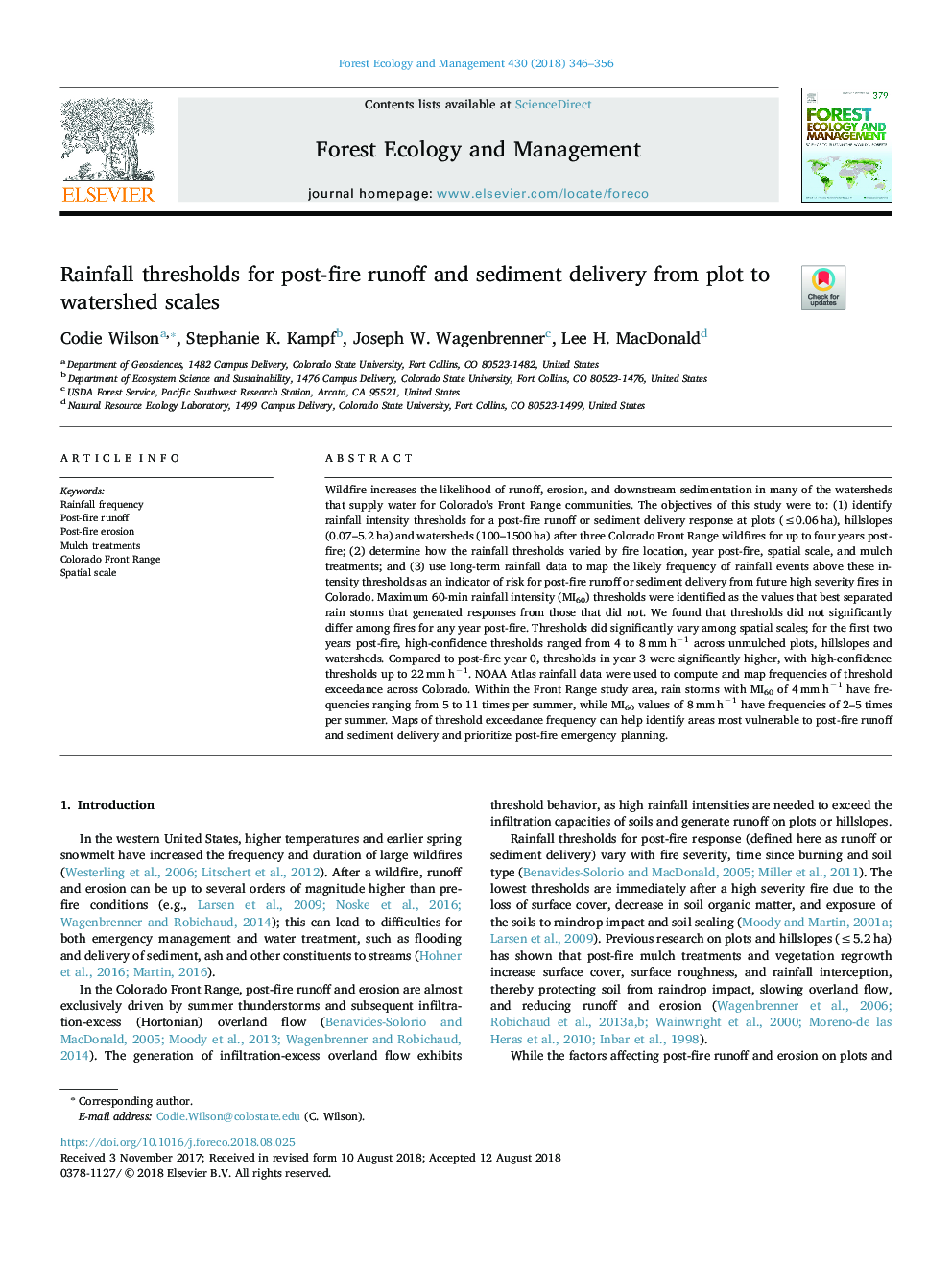| کد مقاله | کد نشریه | سال انتشار | مقاله انگلیسی | نسخه تمام متن |
|---|---|---|---|---|
| 11000031 | 1421330 | 2018 | 11 صفحه PDF | دانلود رایگان |
عنوان انگلیسی مقاله ISI
Rainfall thresholds for post-fire runoff and sediment delivery from plot to watershed scales
ترجمه فارسی عنوان
آستانه بارش برای رواناب پس از آتش سوزی و رسوب از مقیاس به مقیاس حوزه آبریز
دانلود مقاله + سفارش ترجمه
دانلود مقاله ISI انگلیسی
رایگان برای ایرانیان
کلمات کلیدی
فرکانس بارش، رواناب پس از آتش، فرسایش پس از آتش، درمان های مالچ، محدوده جبهه کلرادو، مقیاس فضایی،
موضوعات مرتبط
علوم زیستی و بیوفناوری
علوم کشاورزی و بیولوژیک
بوم شناسی، تکامل، رفتار و سامانه شناسی
چکیده انگلیسی
Wildfire increases the likelihood of runoff, erosion, and downstream sedimentation in many of the watersheds that supply water for Colorado's Front Range communities. The objectives of this study were to: (1) identify rainfall intensity thresholds for a post-fire runoff or sediment delivery response at plots (â¤0.06â¯ha), hillslopes (0.07-5.2â¯ha) and watersheds (100-1500â¯ha) after three Colorado Front Range wildfires for up to four years post-fire; (2) determine how the rainfall thresholds varied by fire location, year post-fire, spatial scale, and mulch treatments; and (3) use long-term rainfall data to map the likely frequency of rainfall events above these intensity thresholds as an indicator of risk for post-fire runoff or sediment delivery from future high severity fires in Colorado. Maximum 60-min rainfall intensity (MI60) thresholds were identified as the values that best separated rain storms that generated responses from those that did not. We found that thresholds did not significantly differ among fires for any year post-fire. Thresholds did significantly vary among spatial scales; for the first two years post-fire, high-confidence thresholds ranged from 4 to 8â¯mmâ¯hâ1 across unmulched plots, hillslopes and watersheds. Compared to post-fire year 0, thresholds in year 3 were significantly higher, with high-confidence thresholds up to 22â¯mmâ¯hâ1. NOAA Atlas rainfall data were used to compute and map frequencies of threshold exceedance across Colorado. Within the Front Range study area, rain storms with MI60 of 4â¯mmâ¯hâ1 have frequencies ranging from 5 to 11 times per summer, while MI60 values of 8â¯mmâ¯hâ1 have frequencies of 2-5 times per summer. Maps of threshold exceedance frequency can help identify areas most vulnerable to post-fire runoff and sediment delivery and prioritize post-fire emergency planning.
ناشر
Database: Elsevier - ScienceDirect (ساینس دایرکت)
Journal: Forest Ecology and Management - Volume 430, 15 December 2018, Pages 346-356
Journal: Forest Ecology and Management - Volume 430, 15 December 2018, Pages 346-356
نویسندگان
Codie Wilson, Stephanie K. Kampf, Joseph W. Wagenbrenner, Lee H. MacDonald,
